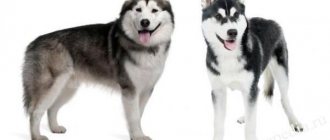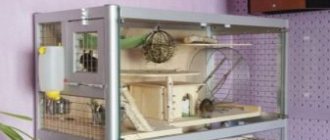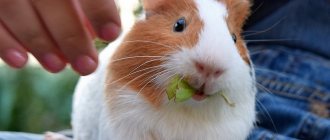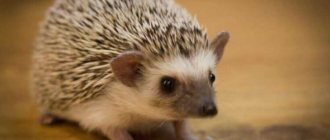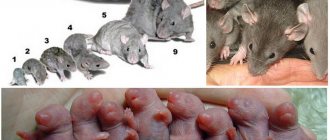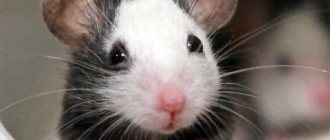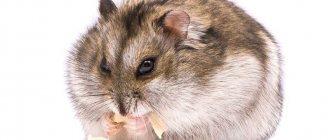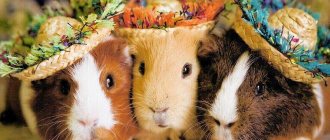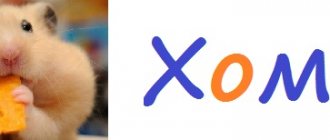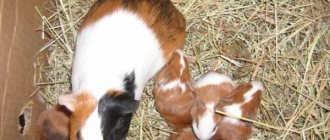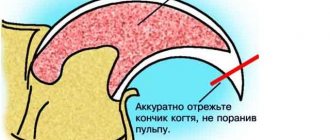Home » Dog Breeds
When a Labrador puppy first appears in a family, few owners think that the dog will go with them through life for ten or fifteen long years.
The first six months, during which the dog’s character and habits will be formed, neatness skills and the basics of obedience will be created - this is the most important period in the dog’s life.
Love for the owner is an important quality, but it appears gradually, in the process of playing together, everyday care of the pet and walks.
Consequently, raising a dog begins from the first moment after it appears in the house.
This Labrador puppy is a big fan of taking pictures.
- 2 Accustoming to neatness
- 3 Vaccinations for Labrador puppies
- 4 Raising a Labrador puppy
- 5 Physical activity
- 6 Contact with the owner
Description of the breed
Today, the Labrador dog is one of the most popular breeds around the world, and the number of its admirers is constantly growing. The pet is considered an impeccable family dog, combining the best qualities: sociability, devotion to the owner, calmness, friendliness. It is generally believed that Labradors were first bred on the Canadian islands. However, there is still much controversy surrounding the origin of the breed.
Some believe that at first Labradors were exclusively black, and were named after labradorite, a mysterious dark stone. The opposite opinion says that the breed originated on the Labrador Peninsula of the same name.
Due to their sharp mind, intelligence and balance, Labradors are often used as service dogs. The training of these dogs is not based on anger and grueling exercises, but solely on loyalty to people.
There have been cases when pets came to the aid of epileptics, since animals have the ability to anticipate seizures. In case of danger, the dogs try to warn the owner about the threat and give a sign for him to find a protected corner for himself.
What a Labrador looks like is known to both experienced and novice dog breeders. This is a large, muscular dog with a solid build. He has a flat skull, a deep chest and a strong back. The main characteristics of the breed include a clear transition from the forehead to the muzzle, medium-sized eyes and drooping ears. Labradors come in 3 colors: black, fawn and brown.
Labrador is a dream dog, attracting with its boundlessly devoted eyes
The feeding pattern for all puppies is the same: a 3-month-old Labrador should be fed 6 times a day, a puppy under 5 months should be fed 5 times, and 7-month-old Labradors should be fed a maximum of 4 times a day. After 9-10 months, dogs switch to 3 feedings a day, and after a year, the Labrador is fed 2 times at a clearly established time.
When to wean from the bitch?
Labradors are large, often multiparous dogs.
If there are many puppies in the litter or the bitch has little milk, then it is often necessary to wean early, at 21-25 days. If there is enough milk, the puppies can continue to suckle their mother for up to 1.5–2 months.
If the bitch had a caesarean section, was treated with antibiotics or on the recommendation of a veterinarian, the puppies may be weaned earlier.
Gallery: Labrador puppies (25 photos)
Feeding dry food
Advantages and disadvantages
Pros:
- Saves cooking time.
- The daily portion of food is indicated on the food packaging.
- There is no need to add vitamin and mineral complexes.
- Convenient for trips and trips.
- A wide range of ready-made food allows you to choose the right one for your dog, taking into account its individual characteristics.
Minuses:
- The presence of preservatives in the feed to increase shelf life.
- Many foods contain little meat of very low quality (offal, animal products - waste from human meat production).
- May cause allergies.
- High price.
- Temperature treatment of food during its preparation “kills” some of the nutrients.
How to choose?
Dry food should meet all your dog's needs and be prepared according to age. A Labrador at the age of 30 days is suitable for professional food for the first feeding of large breed puppies (the so-called “starter”). They contain everything necessary for the growth and development of the puppy, supplements to support joints and ligaments.
Dry food is divided into the following classes:
- Economy _ Minimal, and often negative, benefits - high content of soy, corn, lack of quality meat, dyes, flavors, taste enhancers. Veterinarians do not recommend feeding puppies and dogs with this food. Economy class includes most foods from grocery stores - Pedigree, Darling, Stout, Our Brand, Oscar, Chappi, Trapeza, Cesar, Friskies.
- Premium . Meat is added to offal in small quantities. Soybeans, wheat and corn are most often replaced by rice. Premium food - Royal Canin, Probalance, Pro Plan, Hills, Purina ONE, Advance, Nature's Protection, Chicopee.
- Super premium . More than 25% high-quality meat, healthy by-products, without flavorings or dyes. The super-premium class includes - 1st Choice, Eukanuba, Trainer, Arden Grange, Monge, Brit Care, Pronature Original, Gina Elite, Bosch, Optima Nova, Genesis Pure Canada.
- Holistic . Only natural ingredients. Grain-free or grain-free food. A large percentage of quality meat, vegetables, fruits, herbs, probiotics. Complete and complete food. Holistic feeds – Acana, SAVARRA, Now Fresh, Orijen, Canidae, Grandorf, Go Natural holistic, Farmina N&D, Pronature Holistic, Wolfsblut.
The range of dry food is very wide; a veterinarian can help you choose and advise on the pros and cons.
NOTE!
When feeding dry food, your dog should always have clean water available!
Choosing a puppy
Selecting a purebred puppy is a difficult step that requires maximum responsibility. First of all, you need to determine the purpose for which you want to purchase a pet: do you dream of prizes and awards, or simply need mutual love.
Of course, dogs for participation in exhibitions cost more than ordinary pets. It is also necessary to understand that the guarantor of triumph in bets is neither the cost of the dog nor the owner’s offer, however, responsibility for the pet lies entirely with you, regardless of whether the dog wins prizes or not.
The best period when puppies can already be separated from their mother is considered to be 4-8 weeks. When choosing a Labrador, you need to pay attention to where it is kept. If the dog is in good conditions and surrounded by space and comfort, this indicates the care and love of the owner for his pet.
Introducing complementary foods
The first complementary foods are given to puppies after teething. This is a soaked specialized dry food or homemade diet.
Both of these options have their pros and cons, and professional breeders differ in their preferences. Expert opinion
Tolkachev Andrey Mikhailovich
veterinarian
I do not consider ready-made balanced foods, because I believe that any artificial mixture differs from “live” natural products. And the point here is not in the composition or selection of certain ingredients. Ultimately, you can choose any composition of proteins, fats and carbohydrates with vitamins and microelements, but it is impossible to guarantee the biological activity of the components of a freeze-dried (canned) product and their corresponding effective absorption, digestibility and utilization.
The puppy should be active and cheerful, with a good appetite and regular bowel movements. Any changes in the animal’s well-being and behavior - lethargy, refusal to eat, nausea, vomiting, diarrhea - require consultation with a veterinarian!
Features of care
The dog has absorbed many talents and abilities. She is not only a reliable guard for her owner, but also a loyal friend and a hardworking assistant. Those who decide to purchase a Labrador must take into account that caring for and raising an animal requires considerable effort. This rather temperamental dog needs long walks, training and outings. If the owner fails to provide the dog with such conditions, it will find entertainment for itself, which, most likely, the owner will not like.
Caring for a Labrador's coat is a simple process; you just need to brush the dog once a week with a special rubber brush. If your pet is accustomed to this procedure in time, he will even be able to love it. Brushing is beneficial for a dog as it increases blood circulation, removes fallen hair and stimulates the growth of new hair. Among other things, it is advisable to periodically examine the dog’s ears, eyes, teeth and claws for infections or other diseases, and if signs of any illness are detected, you should immediately seek help from a veterinarian.
How to train a dog
When training a dog, the key is to be patient. No need to be aggressive. Labradors are very smart dogs and quickly grasp everything on the fly, but it takes time for them to start following certain commands. It is best to alternate activities so that your Labrador does not get bored with the activity and become distracted by something else.
It is very important to socialize a Labrador so that the dog does not show anxiety around other people or animals, behaves with dignity during walks, and does not experience stress.
Labrador training
The Labrador is a sincere dog whose character depends entirely on its emotional connection with its owner and other people close to it. The more time and love he gets from his owner, the more trusting and devoted a pet is.
The introduction of a Labrador puppy into the home should be carefully thought out. First of all, you need to remove all dangerous objects from general availability, arm yourself with healthy nutritious food and toys. The pet must also be given a personal place to rest.
Commands such as “Down!” and “Near!”, you should start training your Labrador puppy at 1 month. The dog gets used to his name quickly enough and within a few days begins to understand that his name is his. You should not yell at a dog if it does not come on command, even if there are good reasons for this.
Labrador puppies should be accustomed to intensive training at 3 months. During this period, they are already more intelligent and resourceful. However, each dog shows individual capabilities and training abilities. Some Labradors master the necessary commands in two to four weeks, while others achieve the same results within several months. It is important not to overload the dog and give him time to rest from constant training.
From 4 to 8 weeks (1-2 months) - socialization stage
Once the puppy reaches 4 weeks of age, he will begin to learn the most important things in his life related to social behavior. He will learn not to bite and interact with other dogs and animals.
Social interaction with people is especially important between the 5th and 8th weeks. During this time, the puppies will also learn discipline from their mother. She will begin to wean her puppies and teach them proper manners.
You can begin to gradually introduce regular food into your puppy's diet from about 4 weeks of age. Start with small amounts as the mother is still feeding them.
Make sure to exercise your puppy regularly every day. But do not separate him from his fellow dogs for more than 10 minutes, as this may lead to problems with socialization.
Dogs that have been separated from their mother and litter too early may be more nervous and bark and bite more often. Problems with further training and socialization can also often be attributed to puppies that are separated from their siblings too early.
Photos of Labrador puppies 1.5 months old:
Photos of Labrador puppies 2 months:
History origin
The Labrador is a large enough dog to live carefree in an apartment. There will always not be enough space for either her or you. But at the same time, this dog has plenty of advantages. That's why many people dream of having a pet Labrador.
Dreams simply must become reality, even if it is difficult to believe that what is happening is not a fantasy. Yes, indeed, today everything is possible and a new species that exactly replicates a copy of a popular large animal, only smaller in size, also actually exists.
How could this happen? As with other difficult questions, there will be several answers:
- a man intervened. Dog handlers were interested in developing a new breed that would be more satisfying in size than the original. Labrador is one of the most popular breeds and the demand for it would be even greater. How many apartment dwellers dream of this four-legged friend, but are afraid of the large size of the animal and the small square footage of their own home. The parents of the mini Labrador were a female of the usual standard and a male dwarf Labrador. As a result, the father's genetics turned out to be stronger, and humanity received something average in size and identical in all other respects to a domestic animal,
- inbreeding. If you cross two close relatives, the genetics may fail. This is what happened with puppies that received two completely identical defective genes. As a result, growth slowed down and stopped at a level below fifteen centimeters of the height of a standard adult individual. In addition to short stature, the animal may suffer from other genetic diseases.
Despite such questionable origins, the new variety of mini-Labradors immediately fell in love with many . Contrary to fears of genetic diseases, mini Labradors look quite healthy and happy with life. They have the same energy and need for active games as the standard representatives.
Proper nutrition
When feeding a mini Labrador, you should follow some rules:
- The feeding schedule, time and amount of food consumed at one time must be adjusted depending on the age and health of the animal;
- small dogs are prone to obesity, so you should avoid snacking;
- when feeding natural food, you need to exclude any food from the owner’s table (sweets, smoked foods, spicy, fatty and starchy foods);
- to avoid imbalance in the gastrointestinal tract, mixing ready-made food with natural food, especially dry food, is not recommended;
- food should be fresh, at room temperature, so as not to irritate the pet’s gastric mucosa;
- natural food should not be salted;
- in puppyhood, each new product is introduced gradually and in small quantities to eliminate acute allergic reactions;
- Feeding utensils must be unbreakable and clean; a stand is welcome;
- The dog must have drinking water freely available to him.
Walking and exercise
For proper development and good health, your puppy needs regular walks and physical activity.
Dogs of this breed love to frolic and run outside. The little Labrador is taught to carry out various commands.
But you need to take into account that the pet gets tired quickly. It is necessary to balance the load with the age of the dog. Typically 20–30 minutes a day are allocated for training. The rest of the time can be devoted to games and entertainment.
For walks, the puppy must have a comfortable leash and collar. Your pet should be trained to wear these outdoor accessories from childhood. The choice of special ammunition for an animal must be approached competently.
Collar for Labrador
To choose a good collar, you need to measure the volume of the dog's neck and add a few centimeters to this value. Puppies grow quickly, so it is better to buy a collar for growth.
For puppies, a product made of nylon is better (such collars are lighter). For an adult Labrador, you can safely buy a leather or canvas collar.
Leash for Labrador
A classic walking leash for a dog is usually made of nylon, nylon or leather. For a puppy, it is better to take a leash of moderate length - this will make it easier to restrain the curious little fidget.
A large adult Labrador requires a strong, wide leash with a durable carabiner. A product made of nylon or tarpaulin would be ideal.
Pet health
Animals are quite fragile, so you need to contact a veterinarian with the slightest problem. Only a qualified veterinarian will help the dog. Representatives of this breed are prone to acute respiratory viral infections, allergies, and obesity. Dogs are regularly vaccinated according to the vaccination calendar.
The troubles of caring for a four-legged friend are more than compensated by having a faithful, kind and affectionate companion nearby. Moreover, the flexible nature of the Labrador allows him to get along well with the older generation and children.
First vaccinations
At the age of 1 month, the puppy needs to be dewormed.
The first comprehensive vaccine for dogs against distemper, infectious hepatitis, parvovirus enteritis, parainfluenza and leptospirosis is given 10 days after deworming. After 14 days, a second comprehensive vaccination is given, at this stage vaccination against rabies is also carried out. Quarantine lasts 10-14 days after the second vaccination, revaccination - once a year.
Puppies are vaccinated according to the schedule from the vaccine manufacturer. Veterinary clinics offer vaccines from domestic and imported manufacturers, for example, Biovac, Multikan, Nobivak, Vanguard, Duramun, Eurikan.
